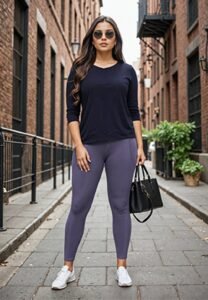Introduction
Women sport wear has undergone significant transformations over the past century, reflecting broader societal changes and advancements in fabric technology. From simple, utilitarian garments to high-performance athletic wear, women’s sportswear now encompasses a wide range of designs tailored to enhance performance, comfort, and style. This article explores the evolution of sport wear women, its impact on female athletes, and the ongoing innovations in the industry.
Historical Background
The history of sport wear women is closely tied to the changing roles of women in society. In the late 19th and early 20th centuries, women participation in sports was limited, and their attire was more focused on modesty than functionality. Early sportswear often consisted of long skirts, corsets, and heavy fabrics, which restricted movement and performance.

The 1920s marked a significant shift with the rise of women suffrage and increased participation in sports. Women began to wear more practical clothing such as shorter skirts and loose-fitting blouses. This period also saw the introduction of the one-piece swimsuit, which revolutionized swimwear by offering greater freedom of movement.
The Influence of Iconic Athletes
The impact of iconic female athletes on sportswear cannot be overstated. Tennis champion Suzanne Lenglen, known for her flamboyant style, popularized the use of pleated skirts and sleeveless tops in the 1920s. Her bold fashion choices challenged traditional norms and inspired other women to adopt more functional and stylish athletic wear.
In the 1970s, track and field star Florence Griffith-Joyner, also known as “Flo Jo,” pushed the boundaries of sportswear with her eye-catching, asymmetrical outfits and long, decorated nails. Her unique style brought attention to the importance of individuality and self-expression in sportswear.
Technological Advancements
Advancements in fabric technology have played a crucial role in the evolution of women’s sportswear. Modern sportswear is designed to enhance performance through the use of innovative materials and construction techniques. Key developments include:
Moisture-Wicking Fabrics
Moisture-wicking fabrics, such as polyester and nylon blends, have revolutionized sportswear by keeping athletes dry and comfortable. These fabrics draw sweat away from the skin to the fabric’s surface, where it evaporates quickly. This technology is essential for maintaining optimal body temperature and preventing chafing during intense physical activity.
Compression Gear
Compression garments, made from elastic materials like spandex, provide support and stability to muscles and joints. They help improve blood circulation, reduce muscle fatigue, and enhance recovery. Compression wear is now widely used in various sports, from running and cycling to basketball and soccer.
Breathable Mesh
Incorporating breathable mesh panels into sportswear improves ventilation and allows for better airflow. This feature is particularly beneficial for high-intensity sports and outdoor activities, where maintaining a comfortable body temperature is crucial.
The Rise of Athleisure
The athleisure trend has blurred the lines between athletic wear and everyday fashion. Athleisure refers to clothing designed for both athletic activities and casual wear. This trend has gained immense popularity due to its versatility, comfort, and style.
Leggings, yoga pants, and sports bras are now staple items in many women’s wardrobes, whether they are heading to the gym or running errands. Brands like Lululemon, Athleta, and Nike have capitalized on this trend by offering a wide range of athleisure products that cater to different tastes and lifestyles.
Body Positivity and Inclusivity
The sportswear industry has made strides towards promoting body positivity and inclusivity. Traditionally, sportswear was designed with a narrow range of body types in mind, often excluding plus-size and differently-abled women. Today, many brands are embracing diversity by offering extended size ranges and adaptive sportswear.
For instance, Nike’s plus-size collection and Under Armour’s adaptive sportswear line demonstrate the industry’s commitment to inclusivity. These efforts not only empower women of all shapes and sizes to engage in sports but also challenge societal norms around beauty and fitness.
Sustainability in Sport wear
As environmental concerns become more pressing, sustainability has emerged as a significant focus in the sportswear industry. Consumers are increasingly seeking eco-friendly options, and brands are responding by incorporating sustainable practices into their production processes.

Sustainable Materials
Brands are exploring the use of recycled and organic materials in sportswear. For example, Adidas has developed a line of shoes and apparel made from recycled ocean plastic. Similarly, Patagonia uses recycled polyester and organic cotton in many of its products.
Ethical Manufacturing
Ethical manufacturing practices, such as fair labor conditions and reduced carbon footprint, are becoming more common in the sportswear industry. Companies like Girlfriend Collective and Pact are known for their commitment to ethical production and transparency.
Customization and Personalization
Advancements in technology have also enabled the customization and personalization of sportswear. Consumers can now design their own sportswear, choosing colors, patterns, and fits that suit their preferences. This trend not only enhances the shopping experience but also allows athletes to express their individuality.
Conclusion
The evolution of sport wear women reflects broader societal changes and technological advancements. From restrictive garments of the past to the high-performance, stylish athletic wear of today, women’s sportswear has come a long way. The influence of iconic athletes, advancements in fabric technology, the rise of athleisure, and the focus on inclusivity and sustainability have all contributed to the dynamic landscape of women’s sportswear.
As the industry continues to innovate, the future of women’s sportswear looks promising. With a growing emphasis on performance, comfort, and style, women athletes can look forward to sportswear that not only meets their athletic needs but also empowers them to express their individuality and embrace their unique bodies.



